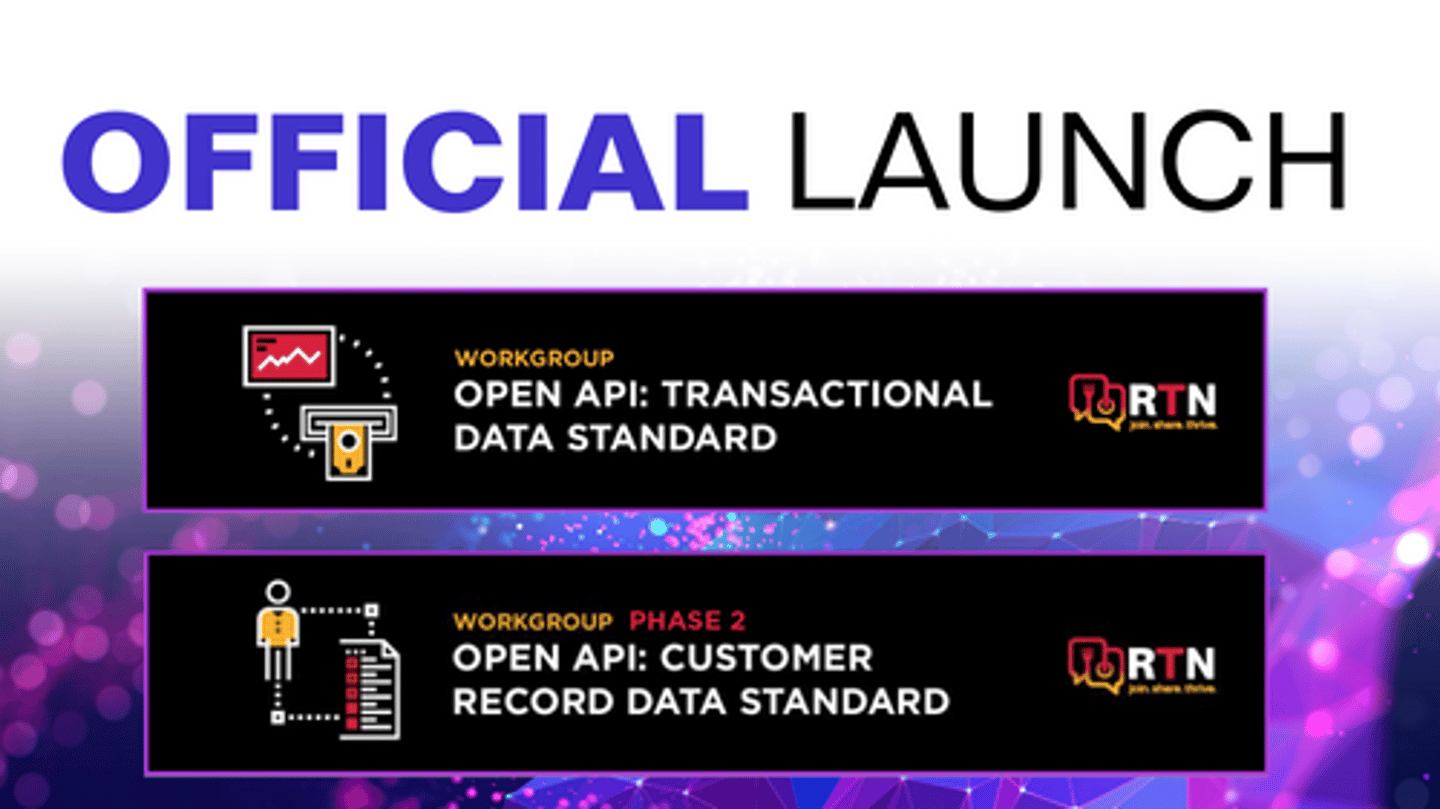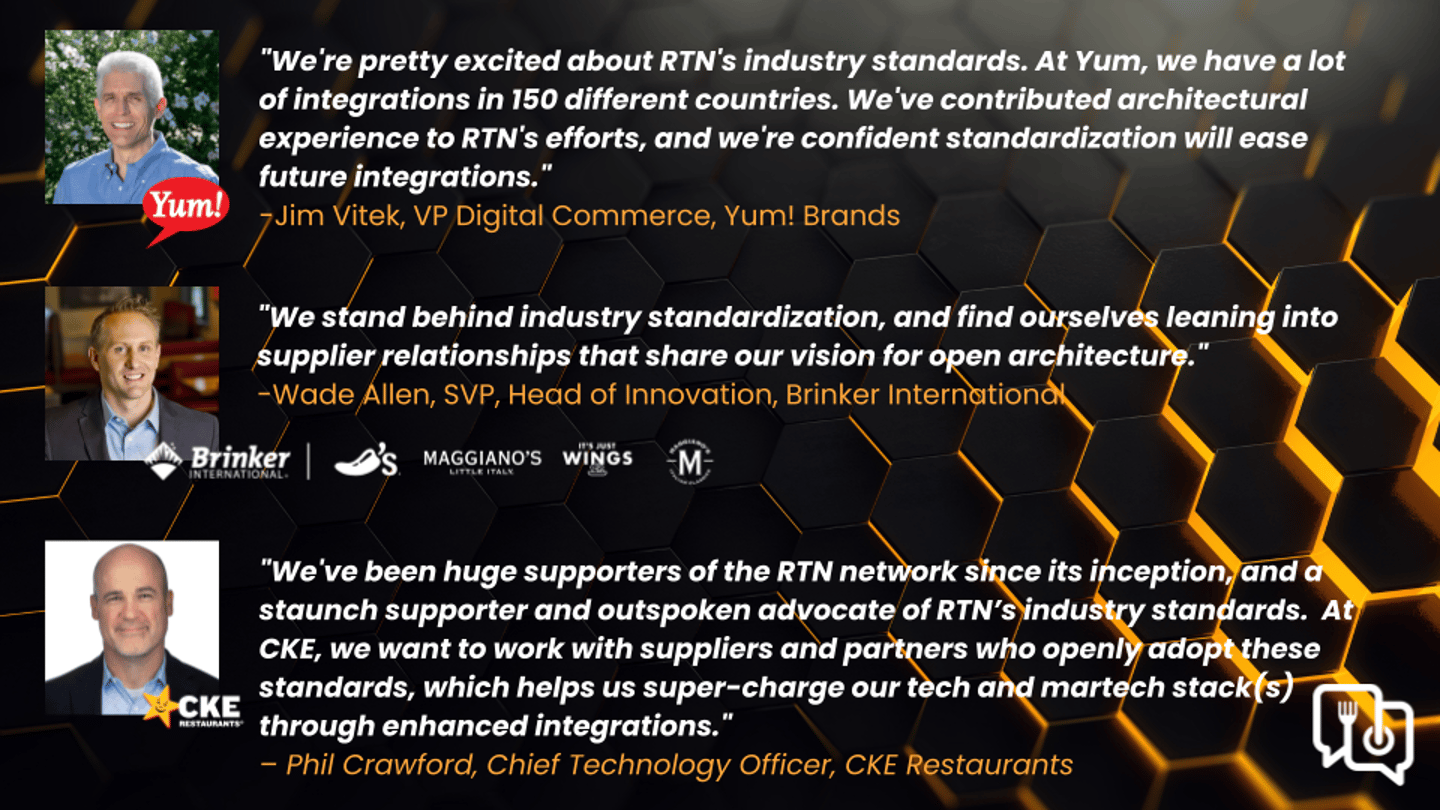RTN Releases Customer and Transactional Data Standards
This week, the Restaurant Technology Network (RTN) officially launched two essential standards for the restaurant technology industry – Transactional Data Standard, Phase 1 and Customer Record Data Standard, Phase 2.
RTN members took to a public Zoom meeting on October 18 to share why standardization is mission-critical for the industry, and how RTN workgroups are bringing them to life.
“These standards alleviate headaches around integration,” explained RTN Co-Founder Angela Diffly. And they’re ready for adoption by operators and tech vendors, always open-source and available via the RTN website.
Two RTN workgroups behind Transactional Data Standard, Phase 1 and Customer Record Data Standard, Phase 2, contributed hundreds of hours to identify, create and refine these standards.
Brinker International, Yum! Brands and CKE Restaurants are just a few of the big brands lending powerful support, and advocating on behalf of industry-wide standardization.
Customer Record Data Phase 2
- Collecting fragmented, non-uniform customer profile
- Managing customer data via disparate systems
- Maintaining integrity when collecting and handling customer data
- Owning the customer, cultivating fans, understanding customer behavior, sparking repeat business
“We all have the same ideology around these industry standards … It just becomes one larger ecosystem for us all basically to speak the same language,” said Phil Crawford, CTO of CKE Restaurants. “That's super important as we continue to grow our marketing and technology stacks, bringing in and out partners, and so forth into the overall ecosystem itself. With these standards RTN is introducing today, our communication will be much easier, and our advancements in technology can be done exponentially quicker.”
Smart System, Dumb Pipes
Customer Record Data Phase 2, took three months and 78 hours of volunteer time, and the workgroup calls were facilitated by AHLA’s Sandy Angel.
The customer data standard alleviates problems around formatting and structure of data collected, explained Tammy Billings. Co-Founder and Head of Industry- Restaurants at Aben.
What the standard does not do is important to understand; it does not manage personal identifiable information (PII), nor does it manage privacy compliance.
“The goal of collaborating across operators and suppliers is to create uniformity before it's needed, specifically data related to customers,” Billings said. “Ultimately, this standard, once adopted widely, will reduce the time and complexity of any integration benefiting both the operator and supplier equally… The time to value will be much faster and easier for everyone involved.”
Easier Integrations
Robert Peterson, Area VP, New Business North America, Oracle Food and Beverage, recalled when RTN was formed four years ago at MURTEC. “Unanimously, brands asked for two things: one was integrations between the third-party delivery platforms, and two was just integrations amongst the platforms… We have done that.”
Transactional Data Standard, Phase 1
Processes and technical requirements that simplify transactional categories and help restaurants aggregate, analyze and ACT on valuable data in real time. Includes:
- Ordering
- Time Card
- Reservations
- Refunds
- POS Drawer
- Use Cases/Model & Diagrams
RTN’s Transactional Data Standard workgroup labored for 22 months and 438 hours to refine the standards that are a time-saver for operators, vendors and consultants alike.
Integrating systems has historically been a heavy lift. Alex Per, CEO of Dataurant, said it can cost upwards of $50,000 to integrate a system. “It can take six months just to plan an integration, and probably one to three months to actually build it, and then maybe another three months of testing with live data.”
“We will all benefit from having common language across all platforms,” added Peterson.
Restaurants are running on razor-thin margins, and IT budgets are slim, said George Hutto, Sr. BI Developer, MOD Super Fast Pizza. When it comes to data integration, these standards will save time and money. “There's a lot of workload for very few people. So if I already know the format, I can get a new data source to my marketing people at a time where that data is still relevant to them,” he said. “For long-term maintenance, I don't have to reinvent the wheel over and over again. I can keep chugging along and putting out good information about our customers and better sales.”
“It’s astounding how much work you can save if you have a standard from one system to another,” said Hutto.
Both operators and vendors can greatly benefit from interoperability and interconnectivity, according to Steven M. Elinson, Managing Director of Travel & Hospitality, Amazon Web Services. For brands adopting these standards, there’s speed to value. “Any brand could add future capabilities, or even new systems, as rapidly as they would like … It also eliminates risk, because if you have a system that's underperforming for you, it makes it very easy to migrate to a new system. Being event-driven is what we should strive for in this industry.”
Christopher Sebes, Partner, Results Thru Strategy has spent a big chunk of his industry tenure as an entrepreneur, building restaurant technology companies. His experience provides a unique perspective when it comes to how standards can fuel the supplier community.. “Simply put, the standards will make the technology companies better. If the company doesn't perform, the pain of changing to another partner is significantly reduced when everybody adopts these standards. It inspires you to do a better job for your customers, because nobody wants to lose their customer. And oftentimes customers stay because the pain of switching out a POS or back-office system is significant.”
What’s Next
Peterson urged brands and vendors to support the RTN standards. Adoption of the standards “is instrumental for us to move forward,” he said.
RTN is always looking to add additional workgroups to solve the industry’s challenges, and is always looking for new members. Mark Mullinax, ConsultR, made a plea to the restaurants: “Let us know what you need. Where else in the industry do you see the industry coming together for the good of the industry and to ease the pain of the operator? What do you see out there that we need to fix? In the RTN workgroups, you can come and go at your leisure and you can join us at any time during the workgroup lifecycle; they meet every two weeks.”
Get Involved
RTN’s Customer Record Data Standard is available now. CLICK HERE.
RTN’s Transactional Data Standard is available now, CLICK HERE.
Current RTN Workgroups, CLICK HERE



